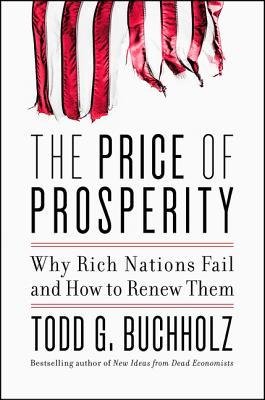The Price of Prosperity
Summary:
America and other developed countries, including Germany, Japan, France, and Great Britain are in desperate straits. The loss of community, a contracting jobs market, immigration fears, rising globalization, and poisonous partisanship—the adverse price of unprecedented prosperity—are pushing these nations to the brink.
Acclaimed author, economist, hedge fund manager, and presidential advisor Todd G. Buchholz argues that without a sense of common purpose and shared identity, nations can collapse. The signs are everywhere: Reckless financial markets encourage people to gamble with other people’s money. A coddling educational culture removes the stigma of underachievement. Community traditions such as American Legion cookouts and patriotic parades are derided as corny or jingoistic. Newcomers are watched with suspicion and contempt.
As Buchholz makes clear, the United States is not the first country to suffer these fissures. In The Price of Prosperity he examines the fates of previous empires—those that have fallen as well as those extricated from near-collapse and the ruins of war thanks to the vision and efforts of strong leaders. He then identifies what great leaders do to fend off the forces that tear nations apart.
Is the loss of empire inevitable? No. Can a community spirit be restored in the U.S. and in Europe? The answer is a resounding yes. We cannot retrieve the jobs of our grandparents, but we can embrace uniquely American traditions, while building new foundations for growth and change. Buchholz offers a roadmap to recovery, and calls for a revival of national pride and patriotism to help us come together once again to protect the nation and ensure our future. (Summary and cover courtesy of goodreads.com)
Please note: I received a free copy of this book in exchange for an honest review courtesy of TLC Book Tours.
Review:
While having some interesting ideas and keeping the content interesting with modern cultural references, my biggest complaint in this book is that it seems very anecdotal. The book provides repeated historical examples, but each one has the caveat – “this is not the only factor”. Though still illustrative and showing a pattern, it would have been nice to see additional statistical analysis of his examples to show more conclusive theses.
That being said, I think this book provides some interesting arguments and certainly had me considering some modern phenomena differently. After reading this book, I’d be interested in reading other books by Buchholz. Three stars because I didn’t find the book compelling enough to eagerly look forward to getting back to it, but still a solid read all around.
Rating: 3 stars!
Who should read it? Folks interested in the premise – what you see is what you get.


